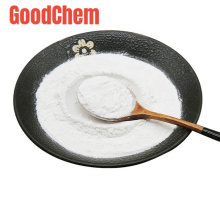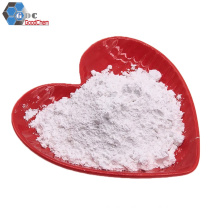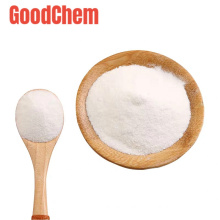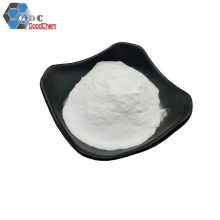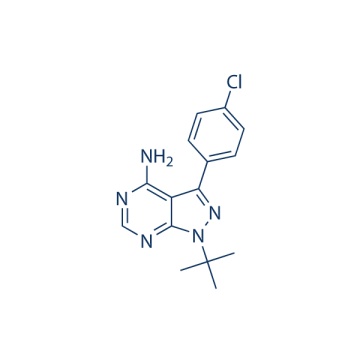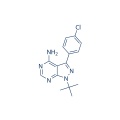.cp_wz table {border-top: 1px solid #ccc; border-left: 1px solid #ccc; } .cp_wz table td {border-right: 1px solid #ccc; borda inferior: 1px sólido #ccc; preenchimento: 5px 0px 0px 5px;} .cp_wz tabela th {border-right: 1px solid #ccc; border-bottom: 1px solid #ccc; preenchimento: 5px 0px 0px 5px;} \ n Peso molecular: \ n 301,77 PP2, um inibidor de quinase da família Src, inibe potentemente Lck / Fyn com IC50 de 4 nM / 5 nM, ~ 100 vezes menos potente para EGFR, inativo para ZAP -70, JAK2 e PKA. \ N Atividade biológica PP2 inibe Src ligando-se a uma área da molécula que não se sobrepõe ao domínio de ligação de ATP. PP2 (20 μM) induz a inibição do crescimento de 40-50% das células HT29, esta concentração reduz a atividade de Src logo em 1 hora e mantém uma inibição de 35% da atividade de Src por 2 dias. PP2 (100 mM) diminui a atividade Src das células HT29 de uma maneira dependente da dose. PP2 (1 mM-100 mM) causa uma inibição do crescimento dependente da dose de células de câncer de cólon humano (HT29, SW480 e PMCO1), células de câncer de fígado (PLC / PRF / 5, KYN-2, Li7 e HepG2), e células de câncer de mama (MCF-7, MDA-MB-468 e BT-474). PP2 (20 μM) aumenta significativamente a agregação na maioria das células cancerosas (HT29, SW480, PMCO1, PLC / PRF / 5, KYN-2, Li7, MCF-7 e MDA-MB-468) de maneira dependente de E-caderina . PP2 (20 μM) aumenta a expressão da caderina-E e também aumenta fortemente a associação da caderina-E com o citoesqueleto de actina nas células cancerosas. PP2 (20 μM) aumenta a expressão de α-catenina, β-catenina e γ-catenina em células HT29, enquanto em células PLC / PRF / 5 e MCF-7, o nível de proteína total de α-catenina não muda, mas os níveis de β-catenina e γ-catenina aumentam ligeiramente. O PP2 inibe a proliferação de duas células de câncer cervical (HeLa e SiHa) de maneira dependente do tempo e da dose. PP2 (10 μM) regula negativamente os níveis de expressão de pSrc-Y416, pEGFR-Y845 e -Y1173 em células HeLa e SiHa. PP2 (10 μM) pode modular a parada do ciclo celular pela regulação positiva de p21 (Cip1) e p27 (Kip1) em células HeLa e SiHa e regulação negativa da expressão de ciclina A e da quinase-2, -4 dependente de ciclina (Cdk- 2, -4) em HeLa e de ciclina B e Cdk-2 em SiHa. PP2 (5 mg / kg / dia) induz alguma diminuição na taxa de crescimento dos tumores primários em relação ao controle tratado com veículo em camundongos SCID inoculados com células HT29 no baço. PP2 (5 mg / kg / dia) induz alguma diminuição na taxa de crescimento dos tumores primários em relação ao controle tratado com veículo em camundongos SCID inoculados com células HT29 no baço. PP2 (5 mg / kg / dia) reduz significativamente o peso relativo do fígado e o volume de metástase do fígado em comparação com os controles em camundongos SCID inoculados com células HT29 no baço. Ratos tratados com PP2 (1,5 mg / kg ip) mostram redução de aproximadamente 50% do tamanho do infarto na ressonância magnética ponderada em T2 e na coloração com TTC em comparação com os controles em ratos com lesão cerebral isquêmica focal. PP2 (1,5 mg / kg ip) resulta em melhor pontuação neurológica do que controles em ratos com lesão cerebral isquêmica focal. Ensaio de cinase de protocolo (apenas para referência): [1]
|
Immune complex enzyme assays
|
The acid-treated enolase is diluted 1:20 with 1× PBS before aliquoting 100 mL/well into a Nunc 96-well high protein binding assay plate. Assay wells are then aspirated; blocked with 0.5% bovine serum, 1× PBS for 1 h at 37 ℃;and then washed five times with 300 mL of 1× PBS/well. The source of Lck is either LSTRA cells or Lck expressed in HeLa cells using a vaccinia expression system. FynT is expressed in HeLa cells using the vaccinia system. Cells (12.5× 106/mL) are lysed in lysis buffer (20 mM Tris, pH 8.0, 150 mM NaCl, 0.5% Nonidet P-40, and 23 trypsin inhibitory units/mL aprotinin), and the lysates are clarified by centrifugation at 14,000 cpm for 15 min at 4 ℃ in an Eppendorf tube. The clarified lysates are then incubated with the appropriate anti-kinase antibody at 10 μg/mL for 2 h at 4 ℃. Protein A-Sepharose beads are added to the antibody/lysate mixture at 250 μL/mL and allowed to incubate for 30 min at 4 ℃. The beads are then washed twice in 1 mL of lysis buffer and twice in 1 mL of kinase buffer (25 mM HEPES, 3 mM MnCl2, 5mM
MgCl2, and 100 μM sodium orthovanadate) and resuspended to 50% (w/v) in kinase buffer. Twenty-five microliters of the bead suspension is added to each well of the enolase-coated 96-well high protein binding plate together with an appropriate concentration of compound and [γ-32P]ATP (25 μL/well of a 200 μCi/mL solution in kinase buffer). After incubation for 20 min at 20 ℃, 60 μLl of boiling 2× solubilization buffer containing 10 mM ATP is added to the assay wells to terminate the reactions. Thirty microliters of the samples is removed from the wells, boiled for 5 min, and run on a 7.5% SDS-polyacrylamide gel. The gels are subsequently dried and exposed to Kodak X-AR film. For quantitation, films are scanned using a Molecular Dynamics laser scanner, and the optical density of the major substrate band, enolase p46, is determined. In companion experiments for measuring the activity of compounds against Lck, the assay plate is washed with two wash cycles on a Skatron harvester using 50 mM EDTA, 1 mM ATP. Scintillation fluid (100 μL) is then added to the wells, and 32P incorporation is measured using a micro-β-counter.
|
Ensaio de células: [3]
|
Cell lines
|
HT29, SW480, PMCO1, PLC/PRF/5, KYN-2, Li7, HepG2, MCF-7, MDA-MB-468 and BT-474 cell lines
|
|
Concentrations
|
~100 μM
|
|
Incubation Time
|
2 days
|
|
Method
|
Cell viability is determined using an in vitro toxicology assay kit following the manufacturer`s instructions. Cells are seeded in 96-well plates at day 0. Starting at day 1, cells are treated for 2 days with each of a series of increasing concentrations of PP2 (1 μM, 10 μM, and 100 μM). At the end of this period, cell proliferation is evaluated by a colorimetric assay based on the cleavage of 3-(4,5-dimethylthiazol-2-yl)-2,5-diphenyltetrazolium bromide by mitochondria dehydrogenase in viable cells, leading to formazan formation. This experiment is repeated three times with 10 determinations/tested concentration.
|
Estudo Animal: [3]
|
Animal Models
|
SCID mice inoculated HT29 cells in the spleen
|
|
Formulation
|
1% DMSO
|
|
Dosages
|
5 mg/kg/day
|
|
Administration
|
intraperitoneal injection
|
|
Solubility
|
1% DMSO/30% polyethylene glycol/1% Tween 80,
30 mg/mL
|
|
* Please note that Selleck tests the solubility of all compounds in-house, and the actual solubility may differ slightly from published values. This is normal and is due to slight batch-to-batch variations.
|
Conversão de diferentes modelos de animais com base em BSA (valor com base em dados das diretrizes preliminares da FDA)
|
Species
|
Baboon
|
Dog
|
Monkey
|
Rabbit
|
Guinea pig
|
Rat
|
Hamster
|
Mouse
|
|
Weight (kg)
|
12
|
10
|
3
|
1.8
|
0.4
|
0.15
|
0.08
|
0.02
|
|
Body Surface Area (m2)
|
0.6
|
0.5
|
0.24
|
0.15
|
0.05
|
0.025
|
0.02
|
0.007
|
|
Km factor
|
20
|
20
|
12
|
12
|
8
|
6
|
5
|
3
|
|
Animal A (mg/kg) = Animal B (mg/kg) multiplied by
|
Animal B Km
|
|
Animal A Km
|
Por exemplo, para modificar a dose de resveratrol usada para um camundongo (22,4 mg / kg) para uma dose baseada na BSA para um rato, multiplique 22,4 mg / kg pelo fator Km para um camundongo e, em seguida, divida pelo fator Km para um rato. Este cálculo resulta em uma dose equivalente de rato para o resveratrol de 11,2 mg / kg.
|
Rat dose (mg/kg) = mouse dose (22.4 mg/kg) ×
|
mouse Km(3)
|
= 11.2 mg/kg
|
|
rat Km(6)
|
Informação Química
|
Molecular Weight (MW)
|
301.77
|
|
Formula
|
C15H16ClN5
|
|
CAS No.
|
172889-27-9
|
|
Storage
|
3 years -20℃Powder
|
|
6 months-80℃in solvent (DMSO, water, etc.)
|
|
Synonyms
|
AG 1879,AGL 1879
|
|
Solubility (25°C) *
|
In vitro
|
DMSO
|
60 mg/mL
(198.82 mM)
|
|
Water
|
<1 mg/mL
(
|
|
Ethanol
|
2 mg/mL
(6.62 mM)
|
|
In vivo
|
1% DMSO/30% polyethylene glycol/1% Tween 80
|
30 mg/mL
|
* <1 mg/ml means slightly soluble or insoluble.
* Please note that Selleck tests the solubility of all compounds in-house, and the actual solubility may differ slightly from published values. This is normal and is due to slight batch-to-batch variations.
|
|
Chemical Name
|
1H-Pyrazolo[3,4-d]pyrimidin-4-amine, 3-(4-chlorophenyl)-1-(1,1-dimethylethyl)-
|
Calculadora de molaridade Calculadora de diluição Calculadora de peso molecular
Grupo de Produto : Angiogênese > Inibidor Src
